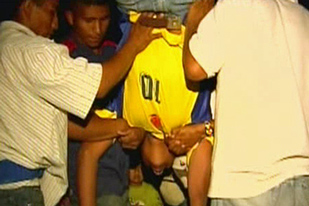Indigenous justice in Colombia
An exclusive report on the Nasa tribe’s traditional community-led judicial system.

 |
| Juan Carlos was hung by his legs until he confessed to the crime |
A remote indigenous Indian community in Colombia has preserved a method of justice that stands in stark contrast to that of Western judicial systems.
The 300,000-strong Nasa tribe has a communal system of justice in which punishment and rehabilitation is undertaken by the community.
Al Jazeera’s Monica Villimizar takes an exclusive look at their traditional ways.
Juan Carlos Troches, from the Nasa tribe, killed his 16-year-old cousin, Armando Dizu, one year ago.
Flor Ilba Troches, Nasa governor, said: “We do not believe in the Western way of punishment. We correct and advise the wrong doer so that harmony is restored at a family and community level.”
The process involves the entire tribal community. The perpetrator and his family sit together on the inside of a human circle, as the victim’s family and the community watch the trial from outside the circle.
Evidence is brought forth and the spiritual leaders reach a verdict after consulting the community.
In this case, Juan Carlos was hung by his legs until he confessed to the crime. As a punishment, he was whipped 30 times, after which the victim’s family felt justice had been done.
| Exclusive report |
|
|
The victim’s father said: “I feel more calm now. Before I felt so much pain I could not work properly and was always thinking about my eldest son.”
Traditional tribal doctors tended to Juan Carlos’s wounds until the following morning. The boy was then locked in a room for an indefinite time period to free his mind of the evil spirits that led him to commit the crime.
He will then be released as the Nasa tribe believes that confinement and isolation from nature harms individuals more than it benefits the community.
Juan Carlos’s punishment includes a 15-year period of manual labour and a period of reparation payments to the family of the boy he murdered.
It is a ceremony that has worked for the Nasa community for hundreds of years, and is likely to continue, despite the efforts of non-indigenous authorities to impose a more conventional system.
